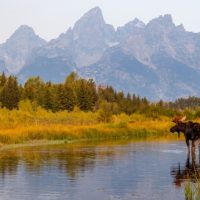Nestled in the southwest corner of the U.S. is the spectacular state of Arizona.
Most widely known as home to the Grand Canyon, Arizona boasts natural wonders and breathtaking views around every corner.
85% of the state comprises wildlife preserves, national forests and parks, “sky islands,” and Native American reservations.
With so much to offer, it’s no wonder nearly 44 million people visit Arizona each year.
Is the “Copper State” on your bucket list this year?
If so, you’re probably wondering what your chances are of encountering a snake.

Contents
So… Are There Snakes in Arizona?
While Texas has the most diverse snake population in the United States, Arizona has a higher concentration of snakes.
The state’s diverse climate and habitats make it a perfect breeding ground for a variety of snakes.
Arizona is home to 52 different snake species.
Of those snake species, 21 are venomous and 13 are of the rattlesnake species.
Whether you plan to spend your time exploring city life in Arizona or taking in the state’s natural wonders, chances are you will encounter a snake along the way.
Let’s look at the most common snakes in Arizona, where they’re most often found, and which could threaten you and your family.
Snake Species in Arizona
Western Diamondback Rattlesnake
The Western diamondback rattlesnake is one of the most common Arizona snakes.
Sometimes referred to as “coon-tail” rattlesnakes, the Western rattlesnakes can be found throughout the entire state.
Whether in the desert, forest, or grasslands, Western diamondbacks hide in rocky crevices and outcroppings.
While its venom isn’t as toxic as the Mojave rattlesnake, Western diamondback rattlesnakes are responsible for more snake bites than any other rattlesnake species.
They are easily identified by the white-lined diamond pattern on their backs, white and black-striped tails, and rattle.
Arizona Coral Snake
Common throughout Arizona, the venomous coral snake poses less of a threat to humans than the rattlesnake.
While its venom is similar to a cobra’s, its small size helps minimize the delivery and effectiveness of their bites.
The Arizona coral snake can be identified by its bright red and yellow bands of color.
These snakes spend their time underground or hiding under logs and leaf piles.
If you encounter a coral snake in the wild, back away slowly.
Arizona Milk Snake
Another common snake found in the “Copper State” is the Arizona milk snake.
Often mistaken for the coral snake, milk snakes also have bright red bands.
Next to its red bands are black stripes, followed by white bands.
If you encounter a red-banded snake in a leaf pile while enjoying the outdoors, exercise caution.
When in doubt, walk away slowly and leave the snake to its nap.
Western Black-Tailed Rattlesnake
Measuring between two and three feet in length, the Western black-tailed rattlesnake can be found in a wide range of habitats in Arizona.
While they enjoy the climate in the woodlands, desert, and grasslands, they prefer more mountainous regions and their foothills.
The Western black-tailed rattlesnake earned its name from its distinctive solid black tail area just before its rattle.
Should you encounter one in the wild, leave it alone.
While these snakes are docile, they will bite if they feel cornered or threatened.
Mojave Rattlesnake
Often referred to as “Mojave green,” the venomous Mojave rattlesnake can be found in the rocky hillsides, desert scrub, and grasslands of Arizona.
These large snakes, which reach up to 4 feet in length, are less prevalent in the rocky or mountainous regions of the state.
The Mojave rattlesnake is often mistaken for the Western diamondback (and vice versa).
Both species have black and white striping on the tail and a diamond-shaped head.
The primary difference is that the Mojave tends to have larger white stripes, whereas the Diamondback has a 1:1 ratio of white to black stripes.
Additionally, Mojaves have more distinct diamonds and fewer black speckles on their bodies.
Because of its strong neurotoxin and defensive nature, Mojave rattlesnakes should be avoided if seen in the wild.
If bitten, try to keep the patient as still as possible and get to a hospital as soon as possible, even if they show no signs of poisoning.
Before your arrival, contact the hospital and let them know you’re on the way and that the patient has been bitten by a pit viper.
Kingsnake
While harmless to humans, the kingsnake is the rattlesnake’s biggest foe.
The most common species found in Arizona are the western black, California, and desert kingsnakes.
They range in color from black or dark brown, with thin bands of cream, yellow, or white around the body.
These bands get wider along the belly.
Reaching between three and four feet in length, kingsnakes are constrictors that prey on rodents, small birds, lizards, and…you guessed it, rattlesnakes!
They are harmless to humans and help control the rattlesnake population.
Is it Safe to Go on a Trek in Arizona?
With all the natural wonders that can be found throughout Arizona, it’s no surprise that many consider it a hiker’s paradise.
There are over 3,200 hiking trails across the state.
As is true on any hike, however, there are several safety measures every hiker should take, regardless of experience level.
Check the weather and trail conditions before heading out on the trail.
Keep in mind that Arizona temperatures can rise quickly.
It’s important that you properly layer your clothing, apply sunscreen before and during your hike, and drink plenty of water.
Experts recommend drinking .5 to 1 liter per hour.
If you’re planning to hike alone, be sure to let someone else know exactly where you’re going.
Remain aware of your surroundings at all times.

Interesting Snake Facts in Arizona
While there are no native aquatic snakes in Arizona, the invasive banded water snake has made its way into Arizona waters.
The gopher snake and the Western diamondback are also often found near bodies of water.
As mentioned, Arizona has over 50 varieties of snakes, 13 of which are rattlesnakes.
That’s more than anywhere else in the world!
Did you know that rattlesnakes shed their fangs every 28 days?
Its fangs are often found inside its prey and digested by the snake’s digestive system.
3 Safety Tips for Exploring Nature in Arizona?
- Don’t underestimate the Arizona heat – Just because it’s a “dry heat” doesn’t mean it isn’t harmful. Try to explore in the early morning and evening, when the temperatures are cooler.
- Hydrate – Start drinking water before you head out on your hike. Bring more water than you feel you need and head back to your vehicle before you’ve consumed half your water.
- Communication is key – While hiking in groups is best, we understand that’s not always possible. Carry a phone with you and be sure to tell friends and family where and when you plan to hike.
Summary
Despite having over 50 species of snakes, Arizona is one of the most-visited states in the U.S.
Regardless of where you are, you’re guaranteed to be awe-struck by the state’s natural beauty and diverse landscapes.
As with anywhere in the world, it’s important to remain vigilant, stay on marked trails, and leave the natural surroundings untouched.
Arizona Safety Overview
READ THE FULL REPORT: Arizona Safety Review
Safety Index:
- OVERALL RISK: LOW
- TRANSPORT & TAXIS RISK: LOW
- PICKPOCKETS RISK: MEDIUM
- NATURAL DISASTERS RISK: HIGH
- MUGGING RISK: MEDIUM
- TERRORISM RISK: LOW
- SCAMS RISK: LOW
- WOMEN TRAVELERS RISK: LOW
Frequently Asked Questions
What is Arizona’s deadliest snake?
While the Mojave rattlesnake’s venom is the most toxic, the Western diamondback rattlesnake is responsible for the most deaths and bites in Arizona.
What part of Arizona has the most snakes?
Snakes can be found throughout the state, with the highest concentration found in the Phoenix and Scottsdale areas.
How common are snake bites in Arizona?
Since not all snake bites are reported to the Arizona poison control, it’s impossible to give an exact number.
However, experts estimate between 250 and 350 snake bites occur in Arizona annually.











